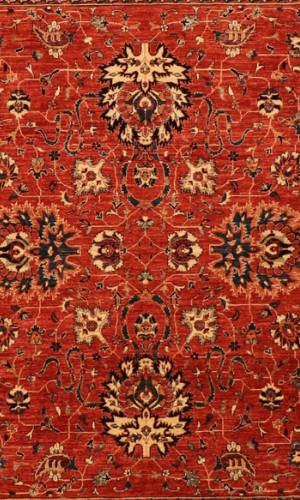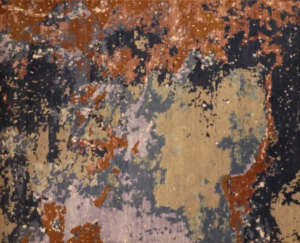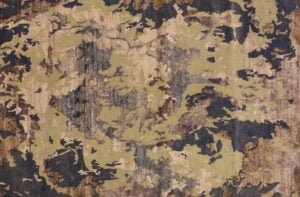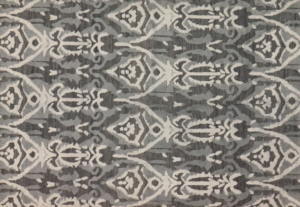Ak Hisser
These carpets are named after the town about sixty miles north-east of Izmir. They have large medallions and geometric designs similar to those which appear on Oushak and Ghiordes pieces. However, no carpets which can definitely be assigned to this town have been made for roughly the last fifty years. Indeed, there seems to be a considerable amount of controversy concerning what Ak Hisser carpets really look like. It is a name which is used fairly regularly for carpets that could quite easily be from Oushak, Ghiordes or even Kirshehir.
Anatolia
This is a slightly confusing term which needs a little explanation. Anatolia is a synonym for that part of Turkey which is in Asia, traditionally called Asia Minor. Anatolian carpets, therefore, are Turkish carpets, not a very helpful definition. However, the term is now generally used for carpets obviously from Turkey but to which no specific place or maker’s name can be attached. It is also often applied to modern Turkish carpets woven with Persian floral designs.
Bergama
Bergama is a small town about sixty miles north of Izmir on the site of ancient Pergamum. The carpets have deep, full-bodied colors and are fairly rare on the market today. They usually have a geometric medallion center and are similar to Ladik pieces. They also have a certain similarity to Kazak carpets from the Caucasus. In the 1920s, a cheap carpet made in Turkey and Greece was marketed as Pergamo. These were not made in the town of the same name nor were they of any quality.
DimirdjiThe town of Dimirdji is half way between Ghiordes and Oushak. As far as is known, no carpets have been made there for at least fifty years. Dimirdji carpets invariably have a distinctive hexagon center which has a red ground, the four corners of the field usually woven in green, and the borders predominantly yellow. They are of considerable rarity.
Ghiordes
The city of Ghiordes which has given its name to the Turkish knot is about seventy miles east of Izmir. The carpets made there are considered amongst the greatest of all Turkish fabrics. It is poetic justice that the Turkish knot should be called Ghiordes, since this is the ancientcity of Gordium which gave its name to the Gordian knot cut by Alexander the Great.
Ghiordes pieces can be divided into three kinds: antique carpets, prayer rugs and modern carpets. To take the last first, modern Ghiordes pieces bear no resemblance, either in design or quality, to antique examples. They are very poor and use Persian designs. Most recent carpet books show a surprising unanimity in either ignoring them completely or dismissing them.
Our first category should for clarity’s sake perhaps be referred to as antique secular carpets and rugs since it is meant to indicate anything which is not a prayer rug. The first point to be made about these is that they are amongst the only Turkish secular carpets which have considerable amounts of green. In many books it is said that green was never used except on prayer rugs but
experience shows this to be incorrect. The secular pieces generally have geometric all-over patterns on an ivory or magenta field. When we said above that Ghiordes carpets are thought of as being the greatest Turkish fabrics, we should perhaps have qualified this statement. Ghiordes prayer rugs unquestionably are amongst the finest of their kind made anywhere in the world; the secular pieces, however, do not tend to be so fine although they hardly merit C. W. Jacobsen’s stricture that they are at the bottom rung of old Turkish carpets.
Ghiordes prayer rugs are amongst the most sought after of all Oriental carpets and are distinctive in design. They nearly always have three wide borders of different geometric patterns between which are three very narrow stripes. In the center of the carpet is the mihrab or niche which has a lamp hanging from the arch in many examples. The two panels at either end of the niche are filled with a geometric design, as are the areas within the center square on either side of the inverted V-shaped arch. The colors are usually rich and varied. The late seventeenth century examples, however, tend to be different in design.
Hereke
Hereke is a town in northwest Turkey on the shores of the Sea of Marmara. A factory was established there by the Sultan of Turkey and subsidized by him. Hereke carpets are almost totally un-Turkish in character for the simple reason that the weavers were all imported from Kirman in Persia. Their only concession to Turkey is that they employ the Turkish knot. Their designs closely follow those of Kirman carpets with naturalistic all-over floral patterns such as the Shah Abbas design whilst animals, rare creatures in normal Turkish fabrics, are frequently found. They also follow the antique Kirmans in using soft pastel colors. Silk Herekes are probably the finest ever woven and often employ silver and gold thread. The high standard of old Hereke carpets, which are extremely valuable, demonstrates more clearly than anything that they were woven on royal looms.
Kirshehir
These carpets are made in the town of this name a hundred miles south-east of Ankara. They are always in the form of prayer rugs and use a large quantity of a distinctive bright grass green. They also always have the three headed flower motif in the borders. They are noted for their strong but perfectly balanced use of color.
Konya
Konya, often spelt Konieh, is the ancient city of Iconium and is approximately 150 miles south of Ankara. The carpets generally use bland mellow colors such as browns and creams which have a beautifully harmonious effect. They normally come in the form of prayer rugs which have a selection of unrelated abstract designs within the mihrab. Secular pieces often have a double pole medallion made up of two octagons. Their designs are, on the whole, crude and they are not well woven. Konya was also capital city of Seljuk civilization for centuries from the 12th – 14th century.
Kulah
Being only fifty miles from Ghiordes, carpets woven at Kulah are extremely similar to those made in the neighboring town. Like Ghiordes pieces, Kulahs are generally prayer rugs which, if they are antiques, are amongst the most admired of all Turkish carpets. The main difference between a Ghiordes and a Kulah prayer rug is that the latter usually has only one crossbar which is located above the niche. And the niche itself does not reach the crossbar as it does in a Ghiordes but only goes about two thirds of the way up the field. An interesting design peculiar to the Kulah is the prayer rug with a double-ended mihrab; this is known as a Kourmur Jur Kulah. The design is woven so as not to give an approximate architectural representation but is merely outlined in white on a geometrically patterned field. Kulah prayer rugs are also often found with one or two rows of cypress trees on a boat-shaped ground symbolizing the soul sailing into the world to come. These rugs are known as tomb rugs.
Ladik
Ladik is a small town near Konya, and in ancient times was called Laodicea. Ladik carpets are extremely rare and very few have been woven since about 1930. Those of the nineteenth century and earlier are amongst the most beautiful and valuable of all Oriental carpets. Most pieces made here are prayer rugs although there are a number of small mats about two feet by three feet. The colors used are predominantly rich reds, pale greens, and blues. The prayer niche frequently has a characteristic shape with a stepped arch, each step having a latch-hook pattern in the large panel always to be found above the arch. Some antique examples have a characteristic triple arch in the mihrab and a panel of tulips upside-down at the base.
Makri
Makri carpets were probably woven in the islands and coastal towns of the gulf of Makri, now called Fethiye, in southern Turkey. The largest island in this vicinity is Rhodes which, at its most northerly point, is only about twenty-five miles from the Turkish coast; Makri carpets are often known as Rhodian, which has led some authorities to believe that at one time they were woven solely on this island. They come mainly in the form of prayer rugs and are brightly colored, usually with a rich blue field on which are woven large, bold, geometric designs in a predominant shade of apricot yellow. One recognizable characteristic is the frequent use of two mihrabs side by side with both ends arched, separated by a thin column. Occasionally the rugs are woven with three mihrabs and sometimes with one but the most usual bright, all-over design, which gives an impression of zigzags covering the whole surface, is easy to recognize and remember.
Melas
These were woven in small towns and villages south of Izmir and marketed in the town of Melas, thus the name Melas is used to describe all of those carpets woven in the area. Weaving has been practically non-existent there during the present century so almost all Melas carpets are antiques. For this reason, and also because they are extremely fine, examples in good condition are rare and valuable. Most pieces are prayer rugs which have their own distinctive mihrab shape, resembling a diamond surmounting a quadrilateral. The field of the mihrab is usually of a rich red-brown and the designs are most frequently woven in an ivory color.
Mudjur
Mudjur carpets are named after the town of Mudjur in central Turkey not far from Kirshehir. No carpets of any quality have been made since the First World War. They are almost all antiques, therefore, and although not quite so highly thought of as, for instance, pieces from Ghiordes and Ladik, they are extremely valuable if in fine condition, probably on the same level as the Melas. Like most of the greatest Turkish weaving, Mudjurs are nearly always prayer rugs and have a distinctive stepped mihrab surmounted by a small tower. The field of the mihrab is almost always a deep rich red.
Oushak
During the sixteenth and seventeenth centuries, the city of Oushak, about seventy miles east of Ghiordes, was the greatest weaving city in Turkey, if not the world. Needless to say, almost all the carpets from this period are now in museums and should not be confused with the crudely made and crudely colored carpets made there this century. Antique Oushaks, examples of which frequently appear in seventeenth century and earlier paintings, are amongst the most Persian-looking of all Turkish carpets, a fact which has led many scholars to believe that they were woven by immigrant Persian artisans; there seems little evidence to support this theory. The usual color scheme of an antique Oushak is a large red field with corner medallions and a central medallion in blue and red made up of fluid geometric forms resembling crystalline structures. Both the Metropolitan Museum and the Victoria and Albert Museum have superb early examples in their collections.
Sivas
These carpets are made in and around the city of Sivas in central Turkey. The best examples are almost always seventy years old or more and bear little relation to the inferior examples made in the last twenty years. There seems to be a certain amount of confusion concerning these pieces. Lewis, in his book, states that the designs are distinctly Turkish in character, whilst Jack Franses remarks that they are often mistaken for Persian and illustrates an example which would seem to prove his point. They were indeed amongst the most finely woven of all Turkish carpets and, with their arabesque medallions, somewhat resemble Oushaks.
Smyrna
Smyrna, now called Izmir, for centuries one of Turkey’s principal sea-ports, is not, nor ever was, a carpet-weaving city, but was a market place for those carpets woven in the neighboring towns and villages. Thus, it is a rather misleading name which is only included here since it is so often found in carpet literature as well as in auction and dealers’ catalogues. The name is frequently used as a generic term for twentieth century Oushak and Ghiordes carpets and denotes a modern piece of poor quality. It is also often used in reference to the Persian-looking carpets made at Sivas and Isparta which were treated with caution. The most typical design for a carpet is an elongated hexagonal field edged along the inside with trefoil sprigs of flowers.
Sparta
Sparta is a corruption of Isparta, the town 150 miles west of Konya in and around which these carpets were woven. Sparta carpets were made by Armenians, many of whom fled from Turkey during the First World War settling in Piraeus and Salonika in Greece. Sparta carpets therefore may be either from Turkey or Greece. They are generally of poor quality and imitate Persian rather than Turkish designs; they have pedantic and unattractive floral patterns. Although occasionally an example of good quality is to be found, they are not generally highly regarded.
Yuruk
Yuruk means mountaineer. These carpets are woven by Nomadic Kurdish hill tribes in eastern Turkey, the same people who inhabit north-west Persia and the Caucasus. They are Caucasian in character, using such typical designs as swastikas and latch hooks. The main field is usually woven with three diamond medallions, either conjoined or separate, and the colors are usually rich red-browns, blues and purples. Yuruks also contain greener than most Turkish fabrics, which is usually of a rather cloying shade.
Before moving on to the conclusion, we should perhaps describe one other very special type of Turkish carpet, which is discussed in detail by Jack Franses in his book European and Oriental Rugs. This is the Koum ka Pour (meaning gates to the sands) which type was woven for a period of only about twenty years, between roughly 1890 and 1910, in a suburb of Istanbul. They were woven under royal patronage by the master Turkish weaver Kanata and are Persian-floral in character. They are characterized by their use of gold and silver threads which were woven into decorative flower patterns of many colors. Of exceptional beauty and rarity, these carpets, unlike any others ever woven in Turkey, have a place in the history of carpet-weaving which may be compared to that of Faberge, late 19th century Russian gold-smith in the field of applied arts. Koum ka Pours are described by Mr. Frances’ a dealer considerable experience, as being amongst the greatest carpets ever made.




